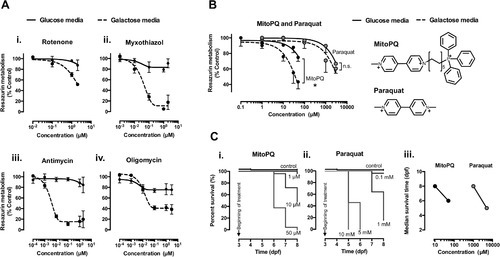Fig. 1
- ID
- ZDB-FIG-190528-1
- Publication
- Pinho et al., 2018 - Mitochondrial superoxide generation induces a parkinsonian phenotype in zebrafish and huntingtin aggregation in human cells
- Other Figures
- All Figure Page
- Back to All Figure Page
|
Drug effects on cell metabolism and zebrafish survival. (A) Resazurin metabolism of U2OS cells grown in glucose media(glycolytic conditions) and galactose media (OXPHOS-dependent conditions), after 24 h of treatment with increasing concentration of mitochondrial inhibitors: (i) rotenone – complex I inhibitor, (iiand iii) myxothiazol and antimycin – complex III inhibitors; and (iv) oligomycin – ATP synthase inhibitor; n = 3–4 independent experiments. (B) Resazurin metabolism of U2OS cells in glucose versus galactose media after treatment with MitoPQ and paraquat(left); and their chemical structures (right). Note that the decyl triphenylphosphonium lipophilic cation moiety targets MitoPQ to polarized mitochondria, and that MitoPQ was 100-fold more potent than paraquat in galactose media; n = 3 independent experiments, * P < 0.05. (C) Kaplan-Meier survival analysis of zebrafish larvae exposed to MitoPQ (i), paraquat (ii), or solvent(control), n = 24–50 larvae; and respective median survival times (iii).
|
Reprinted from Free radical biology & medicine, 130, Pinho, B.R., Reis, S.D., Hartley, R.C., Murphy, M.P., Oliveira, J.M.A., Mitochondrial superoxide generation induces a parkinsonian phenotype in zebrafish and huntingtin aggregation in human cells, 318-327, Copyright (2018) with permission from Elsevier. Full text @ Free Radic. Biol. Med.

